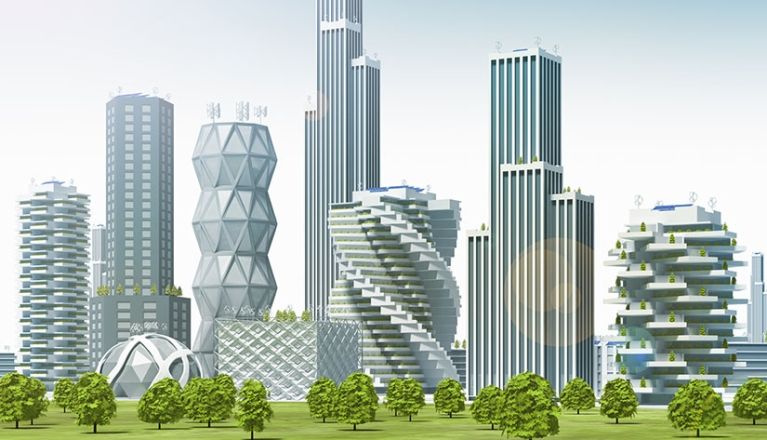- #Environment
- 2021/04/07
- 0
-
7
The considerable challenges facing sustainable cities
More than half of the world's population now live in urban areas. Cities account for most of the planet's energy consumption (75% of energy produced) and they generate 80% of greenhouse gas emissions. Faced with the climate emergency, more and more cities are adapting their urban planning policies to incorporate sustainable development in all its aspects – the environmental, economic and social impact.

What is a sustainable city?
A sustainable city is an urban area that simultaneously pursues environmental, economic, and social policies (the three pillars of sustainable development). Sustainable urban planning takes a project-based approach. It involves thinking differently, creating a new model for urban planning and development, and inventing new forms of housing, transport, and consumption. In industrialised countries, action in this area is most often taken at a neighbourhood level, in eco-neighbourhoods. This new form of urbanisation starts by prioritising several objectives that exemplify the sustainable development approach.
What are the objectives of a sustainable city?
? Achieving carbon neutrality
This involves implementing energy efficiency measures in buildings and infrastructure and using renewable energy sources. There are alternatives to fossil fuels, such as solar energy produced by solar panels.
? Significantly reducing transport emissions (green mobility)
The goal is to make the city more compact so that fewer resources are used. Reducing transport emissions requires investments in green infrastructure and public transport systems and the "offsetting" of carbon emissions arising when there is no alternative to road transport. Incentives to use green and/or non-motorised personal means of transport are also important.
? Building green homes
This involves using, wherever possible, locally produced recycled and recyclable raw materials and construction materials and energy recovery solutions (see our article on sustainable architecture).
? Rethinking waste management to achieve zero waste
Zero waste can be achieved via three types of action:
- reusing, recycling, and composting most waste;
- reducing waste production at source via eco-design;
- generating energy from waste.
? Promoting local food production
This involves producing as much food as possible within the city by developing urban agriculture, and buying local products to reduce food miles.
? Developing green spaces
The aim is to maintain, create and promote green spaces and the species they host (for example by transforming inner city brownfield sites).
? Fostering social diversity to ensure equal access to essential services
A sustainable city must be more than an ecological project. It must incorporate a social dimension aimed at reducing social inequalities between neighbourhoods.
Copenhagen – Europe's top sustainable city
Copenhagen is one of the most advanced sustainable cities in Europe. It has set ambitious goals: to be carbon neutral by 2025, with 100% zero-emission vehicles and 75% of journeys completed on foot, by bicycle, or by public transport. These goals are driven by very strong popular support for the green transition and widespread use of green transport solutions. Reducing energy use is one of the city's key objectives, with 400 km of cycle paths, a major energy-efficiency renovation programme, the development of offshore wind power, etc.
And in France?
In France, the government launched the transition to sustainable urban planning ten years ago with the Grenelle II law, as part of the Sustainable Cities Plan. This led to the introduction of the ÉcoQuartier (eco-neighbourhood) certification process. The government recently outlined a new roadmap for more sustainable cities, with the goal of cities becoming carbon neutral by 2050. This plan includes the creation of an association, France Ville Durable, bringing together the stakeholders in sustainable cities (local authorities, businesses, the government, public sector entities, associations), and a trial of net positive energy and low carbon neighbourhoods. The aim is to expand the sustainable city approach across the country.
The challenges of developing sustainable cities in France
Reconciling the climate emergency with local democracy is one of the challenges of developing sustainable cities in France. Prior consultation of stakeholders is crucial to the successful development of a sustainable city. If this consultation is not organised, the project will not achieve its objectives because the new neighbourhood will not meet requirements and people will not want to live or work there. Or even if people or businesses do move in, the new area may not develop a real community spirit if leisure facilities are not directly available in the neighbourhood.
In addition, the people who live in the city must adopt environmentally friendly behaviour to successfully reduce the use of resources. Urban planning must enable citizens to adopt more sustainable lifestyles. However, the health crisis has increased demand for larger homes with access to an outside space or a garden, which goes against the principle of building denser housing units and low carbon neighbourhoods…
Sources : WWF ; France Ville Durable ; banquedesterritoires.fr ; smart-city.eco




